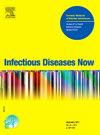Retrospective analysis of discharge antibiotic selection and 30-day readmission rate for community acquired pneumonia
IF 2.2
4区 医学
Q2 INFECTIOUS DISEASES
引用次数: 0
Abstract
Purpose
This study evaluates 30-day community-acquired pneumonia (CAP) readmission rates dependent on discharge antibiotic selection.
Patients and methods
This is a retrospective, single-center, observational study of patients discharged with a diagnosis of CAP from July 1st, 2022 through June 30th, 2023. Patients included those empirically treated with ceftriaxone plus azithromycin and with documentation of discharge antibiotics.
Results
Beta-lactam combination therapy represented the most frequent discharge antibiotic regimen (n = 161). Only 6/368 patients were re-admitted within 30 days. No significant difference was detected in readmission rates between beta-lactam and non-beta-lactam monotherapy (p = 0.921), or between combination therapy and monotherapy (p = 0.604). The average total duration of combined inpatient (4 days) and outpatient (5 days) antibiotic therapy was 9 days.
Conclusion
Broad-spectrum or combination antibiotic therapy at discharge did not result in lower readmission rates. The significant antibiotic stewardship opportunities that remain at transition from in-patient to out-patient care should prioritize narrow spectrum, short-course, monotherapy antibiotic regimens when the causative pathogen is unknown.
社区获得性肺炎出院抗生素选择及30天再入院率的回顾性分析。
目的:本研究评估30天社区获得性肺炎(CAP)再入院率与出院抗生素选择的关系。患者和方法:这是一项回顾性、单中心、观察性研究,研究对象为2022年7月1日至2023年6月30日诊断为CAP的出院患者。患者包括经经验使用头孢曲松加阿奇霉素治疗并有出院抗生素记录的患者。结果:β -内酰胺联合治疗是最常见的出院抗生素方案(n = 161)。只有6/368例患者在30 天内再次入院。β -内酰胺与非β -内酰胺单药治疗的再入院率无统计学差异(p = 0.921),联合治疗与单药治疗的再入院率无统计学差异(p = 0.604)。住院(4 天)和门诊(5 天)抗生素治疗的平均总时间为9 天。结论:出院时广谱或联合抗生素治疗均未降低再入院率。在从住院到门诊护理的转变中,重要的抗生素管理机会应该优先考虑在致病病原体未知的情况下使用窄谱、短疗程、单药抗生素方案。
本文章由计算机程序翻译,如有差异,请以英文原文为准。
求助全文
约1分钟内获得全文
求助全文
来源期刊

Infectious diseases now
Medicine-Infectious Diseases
CiteScore
7.10
自引率
2.90%
发文量
116
审稿时长
40 days
 求助内容:
求助内容: 应助结果提醒方式:
应助结果提醒方式:


